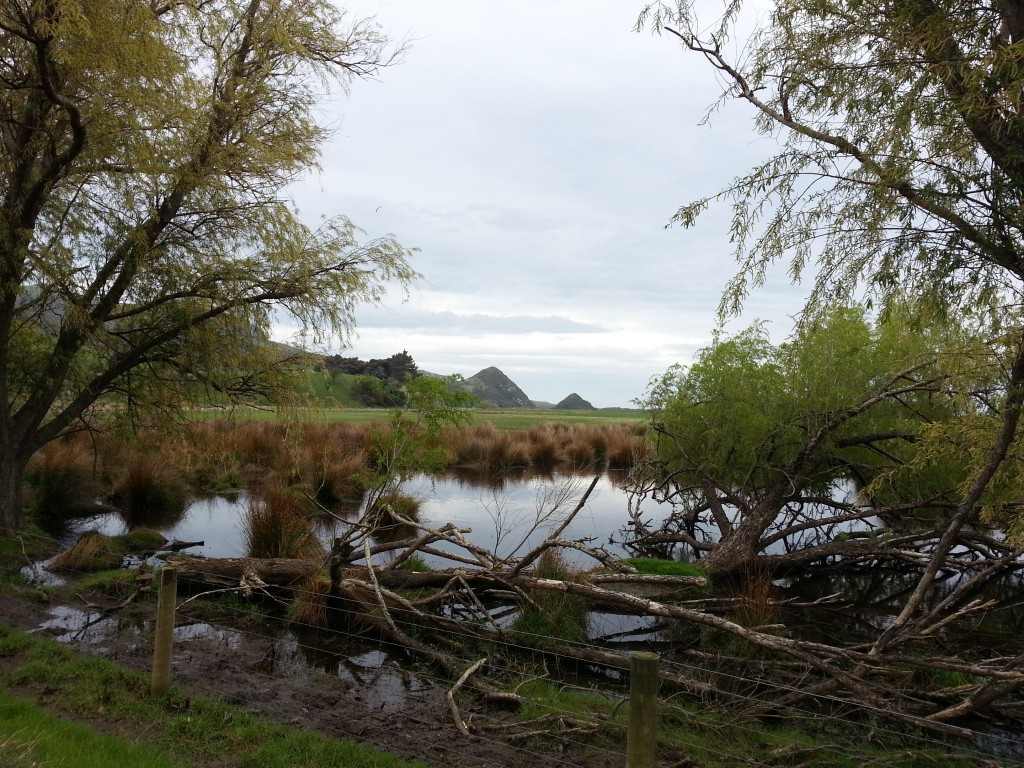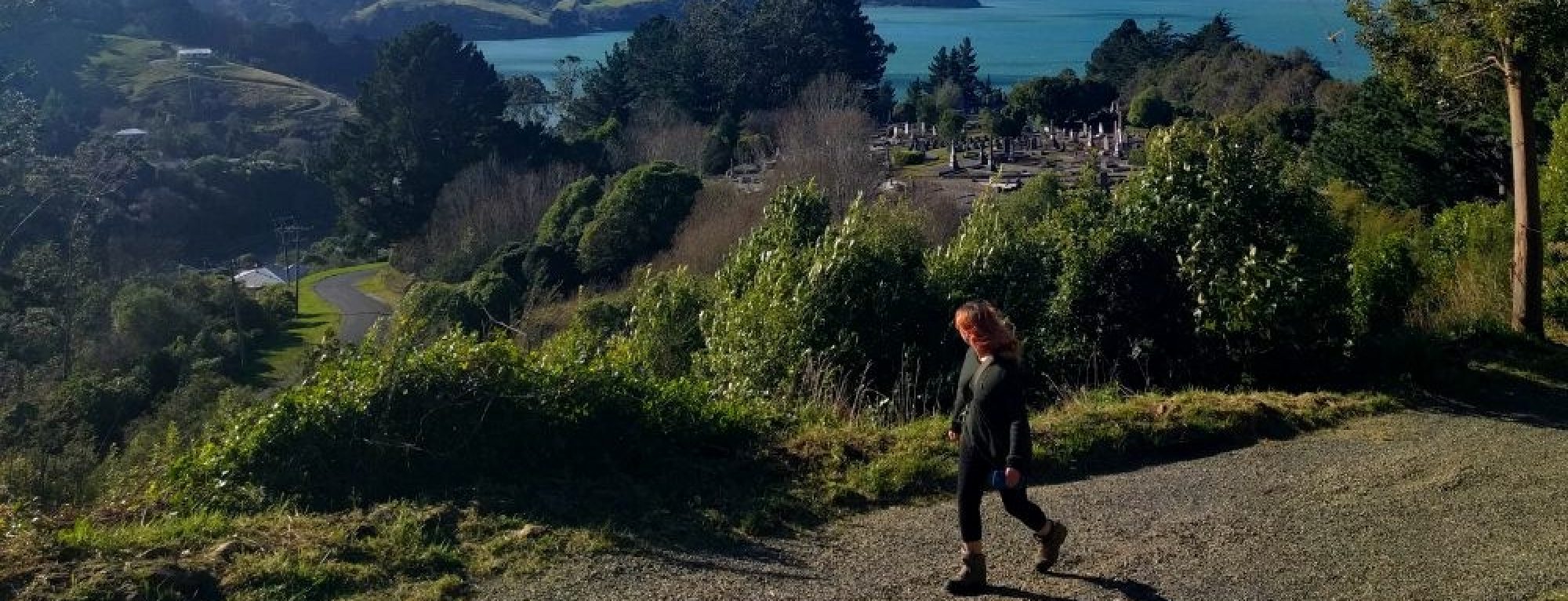Another Monday, another adventure! Once again we wend our familiar way along Portobello Rd all the way to Weir Rd. We crossed over to Dick Rd, spying a family of paradise ducks at the swampy corner. The little black and white balls of fuzz hurried after their mother as she shepherded them away from our dangerous presence.
We turned left and parked not far along the road, by the DOC marsh sign warning visitors not to disturb the delicate salt marsh plants.
 The tide was low once again, giving us lots of room to walk down the beach. We headed off along the coast of Papanui Inlet as the occasional crab scurried out of our path.
The tide was low once again, giving us lots of room to walk down the beach. We headed off along the coast of Papanui Inlet as the occasional crab scurried out of our path.
We hadn’t gone far when we noted an area where the grassy land had eroded, exposing layer upon layer of shells. Perhaps, we surmised, an old midden?

Papanui inlet has a long history of Maori occupation, being both sheltered and near to sources of seafood and timber, and many artefacts have been recovered after erosion has exposed them. In 2014 an ancient waka was discovered near the estuary, thought to be the second oldest ever found in New Zealand at almost five hundred years old. This was long before the arrival of Europeans and before most of the waves of Maori settlement on the peninsula.
Continuing, we were able to step up on to a dirt road that ran parallel to the beach, with pine trees and boggy farmland on our other side. Approaching the estuary, we discovered a large macrocarpa had fallen across the road, through which a tunnel had been carved, quite recently judging by the fresh smell of the sawn branches. Perhaps this was another victim of last week’s extreme wind event.
Recalling a recent event in Ireland, in which a human skeleton had been found amongst the roots of a fallen tree, combined with the knowledge that human remains are occasionally found in the area, I bravely investigated.
The roots were very shallow, and not very remarkable, except…

I fled from the haunted scene, pausing only for the mandatory cell phone snap.
We passed some baches (the correct plural, according to Wikipedia), climbed a stile, and followed a vehicle track through the flat. We briefly investigated a cement brick construction and nearby concrete step to nowhere, concluding a bach must have been removed from the site. then crossed back over to the beach.
A commotion in the tussock caught my eye, and I watched as two sea lions emerged on to the beach ahead. They appeared to be having an argument…or perhaps a romantic moment? We sneaked past while they were distracted, amorously or otherwise.
We reached the mouth of the estuary, and turned on to Victory beach, the longest beach on the peninsula at 3.5 kilometres. I peeled my eyes because there was something I was very much looking forward to seeing.
Yes! The rusty flywheel from the SS Victory was visible in the surf, still being battered by waves 154 years after she ran aground and gave the beach its name.

The Victory departed for Melbourne on at 4.30pm on 3 July 1861 with a cargo of humans, mail and other goods, but ran aground only one and a half hours later.
The steamer was under the charge of Captain James Toogood when it left Port Chalmers. It was growing dark as he exited the harbour and ordered a course to the south-south-west, intending to take her three miles clear around Cape Saunders.
But there were many factors working against the Victory that night. The crew could not navigate by compass, as the iron hull and the coastal location interfered with their instruments. They needed to judge their position by sight, but the night was dark and the weather was hazy. There may have been a current pushing the ship towards land while the crew remained unaware.
In the aftermath of the grounding, Captain Toogood admitted that the ship may already have closer to land than he realised when he handed her over to Thomas Sampson, the third mate, with explicit instructions to call him immediately if they were drawn towards the coast.
Sampson claimed that shortly afterwards the Chief Mate, George Hand, took over. Sampson also claimed that he saw a looming shape in the darkness and pointed it out, but Hand scoffed that it could not possibly be the coast.
About seven minutes later, the vessel struck. Luckily, she struck the soft sand of Wickliffe Bay, and so nobody was harmed. Had they struck anywhere else, there might have been a terrible loss of life.
The Captain and third mate both rushed back to the bridge, and both reported that the Chief Mate was nowhere to be seen when they arrived.
At first, the Chief Mate denied he had ever been put in charge of the vessel, but witnesses claimed that he later admitted he had been. The Captain, perhaps very aware that blame would have to be laid, paraded the Chief Mate before his saloon passengers to demonstrate that he was drunk, and placed him in his room under arrest.
The Captain then ordered the engines to be reversed at full speed and struggled for an hour and a half to unstick the ship from her unfortunate position. When that proved futile, he instead ran her forward up the beach. At about midnight a boat was lowered, and the process of shuttling the passengers, mail, and baggage to shore began.
It was not possible to refloat the Victory with the meagre tools at hand in Dunedin at the time. Instead the ship was auctioned off on the beach as she lay, fetching only £1900 against an estimated value before the disaster of £25000.
It was not long before George Hand appeared before the magistrates, accused of drunkenness and abandoning his post. The defence however railed against Captain Toogood, accusing him of “inconceivable recklessness” in navigating the ship, conducting his crew with an “entire absence of discipline” and a “daring and wicked” attempt to pass the blame on to his Chief Mate.
The magistrates did find Hand guilty, and sentenced him to three months hard labour. However, they also had strong words for the Captain, agreeing that “unwarranted carelessness and lack of discipline” prevailed on board ship. The Captain should have stayed on deck, or at the very least ensured sufficient look out was being kept. Perhaps it was not even possible for the Chief Mate to recover the ship from the precarious position the Captain had placed it in before retiring to tea. Moreover the Chief Engineer had also left his post in the engine room without ensuring anybody would arrive to take over. And finally, the crew were able to purchase liquor on board without any oversight from the Captain, at the discretion only of the Providore, who had a vested interest in selling his wares.
From the midst of a jumble of mistakes, incompetency and poor circumstances, George Hand emerged the scapegoat.

We contemplated the scene a while, then decided to proceed down the beach rather than double back the way we came. There were a few spots of rain as we walked between the sharp dune wall and the sea.
There was no clear signage indicating the way off the beach on to Okia Flat, so we were forced to use our tracking skills, following a set of footprints to a slice in the dune, up which we could climb to the wetlands beyond.
We followed the wide fire break through bracken and flax and assorted other wetland natives, finding the path back to the little pyramid. After that, we followed the long straight to the Dick Rd car park, passing numerous pukekos along the way. We admired the lambs, now much bigger and more robust than they were six weeks ago (has it been that long already?).
We continued down the road, despite the intimidation attempts of some noisy geese.

Eventually, we reached the car and climbed in with relief. At the Weir Rd corner, we once again greeted our family of ducks, who remained unimpressed by our presence.
As we wended our way back, the rain began to fall in earnest.

Great day out…
would like to see photos of three smaller pyramids on victory beach area.
That is a awesome story!
Cribs not baches. Too far south for a bach. I managed to reach out and touch the flywheel yesterday. Lots of sand on the beach and a low tide.